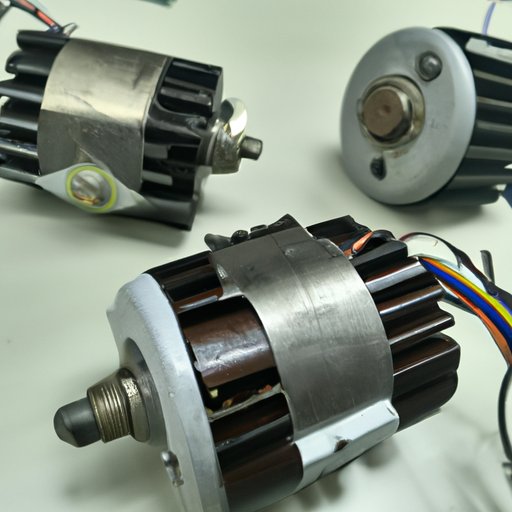Introduction
A DC motor is an electric motor that runs on direct current (DC) electricity. It is used in a wide range of applications, from powering small electronic devices to large industrial machines. In this article, we will explore the workings of a DC motor and discuss its components, operation, advantages, and maintenance requirements.
Explaining the Basics of How a DC Motor Works
At its core, a DC motor works through the interaction between an electric current and a magnetic field. This process is known as electromagnetic induction and it is what causes the motor to produce torque and rotation.

Describing the Components and Operation of a DC Motor
The structure of a DC motor consists of several components. The armature is the part of the motor that rotates, while the field magnet is a permanent magnet that provides the main magnetic field. The commutator is a split ring that helps to reverse the direction of the current flowing through the armature. And finally, the brushes are two pieces of conductive material that transfer electrical current to the commutator.
The operation of a DC motor starts when electricity flows through the armature, which creates a magnetic field. This field then interacts with the field magnet, causing the armature to rotate. The commutator then reverses the direction of the current, resulting in the continuous rotation of the armature.
Examining the Advantages of Using a DC Motor
DC motors have several advantages over other types of motors. For one, they are highly efficient, meaning they can convert most of the energy they consume into mechanical energy. Additionally, they can receive variable voltage, allowing them to easily adjust their speed. Finally, they are relatively inexpensive, making them a popular choice for many applications.

Illustrating the Working Principles of a DC Motor
The working principles of a DC motor can be broken down into three steps. First, the electric current running through the armature induces a magnetic field around it. This field then interacts with the field magnet, creating a force that causes the armature to rotate. Lastly, the commutator reverses the direction of the current, resulting in the continuous rotation of the armature.

Analyzing the Different Types of DC Motors
There are three main types of DC motors: series, shunt, and compound. Series motors have high starting torque and are typically used in applications such as elevators and hoists. Shunt motors have low starting torque and are often used in fans and blowers. And compound motors combine the features of both series and shunt motors and are used in applications such as printing presses.
Outlining the Maintenance Requirements for a DC Motor
Regular maintenance is essential for proper functioning of a DC motor. This includes cleaning the motor regularly to remove dust and debris, checking all connections to ensure they are secure, and lubricating the moving parts of the motor to reduce wear and tear. Additionally, it is important to check the brushes for signs of wear, as worn brushes can cause the motor to run inefficiently.

Comparing Alternatives to a DC Motor
There are several alternatives to a DC motor, including AC motors, brushless DC motors, and stepper motors. AC motors are more efficient than DC motors and can be used in applications requiring more power. Brushless DC motors are more efficient and require less maintenance than traditional DC motors. And finally, stepper motors provide precise control but are more expensive than other types of motors.
Conclusion
In conclusion, DC motors are widely used in a variety of applications due to their efficiency, ability to receive variable voltage, and low cost. Understanding the basics of how a DC motor works, its components, various types, and maintenance requirements is critical for proper functioning and longevity. Although there are alternatives to a DC motor, such as AC motors, brushless DC motors, and stepper motors, they are often more expensive and may not be suitable for all applications.
(Note: Is this article not meeting your expectations? Do you have knowledge or insights to share? Unlock new opportunities and expand your reach by joining our authors team. Click Registration to join us and share your expertise with our readers.)
